While it used to be difficult to find any dinosaurs at all that started with the letter X, there are now at least 19 of them! A big reason for this proliferation is a number of discoveries made in China in recent decades, and the subsequent use of Chinese names for them. Read on to learn all their names, including how to pronounce them and what they mean.
1. Xenoceratops
Pronunciation: zee-noe-seh-rah-tops
Name means: “alien horned face”
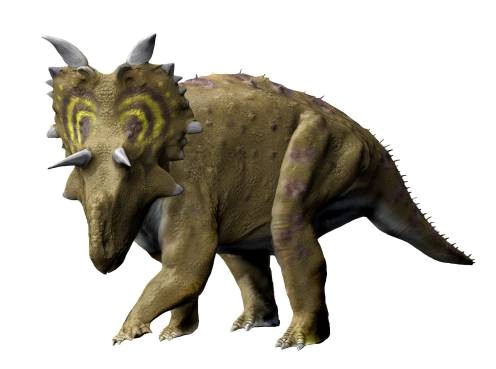
Artist’s reconstruction of
Xenoceratops foremostensis.
©Nobu Tamura email:[email protected] http://spinops.blogspot.com/ http://paleoexhibit.blogspot.com/, CC BY-SA 4.0, via Wikimedia Commons – License
Xenoceratops is a genus of centrosaurine ceratopsid dinosaur that lived during the Late Cretaceous period (middle Campanian stage). Researchers named the type species Xenoceratops foremostensis in 2012 from skull fragments found in the Foremost Formation in Alberta, Canada. The binomial name refers both to the place it was found in and the lack of other ceratopsian species known from this area. They described it as a large herbivore around 6 m long that weighed 3 mt (metric tons) and had a large double-horned frill with two long brow horns.
2. Xenoposeidon
Pronunciation: zee-noe-po-sy-den
Name means: “strange Poseidon”

Artist’s reconstruction of
Xenoposeidon proneneukos.
©Levi bernardo, CC BY-SA 3.0 – License
Xenoposeidon is a genus of rebbachisaurid sauropod dinosaur that lived in the Early Cretaceous period (Berriasian age). Researchers named the type species Xenoposeidon proneneukos in 2007 from vertebrae remains found in the Hastings Bed Formation in East Sussex, England. The genus name is Greek for “strange Poseidon,” while the species name is Greek for “foward sloping,” referring to the unsual anterior sloping of the neural arch. They described it as a large herbivore about 15-20 m long.
3. Xenotarsosaurus
Pronunciation: zee-noe-tar-so-sore-us
Name means: “strange tarsus lizard”

Artist’s reconstruction of
Xenotarsosaurus bonapartei.
©dukanguyen/Shutterstock.com
Xenotarsosaurus is a genus of abelisaurid theropod dinosaur that lived during the Late Cretaceous period (Cenomanian-Turonian stages). Researchers named the type species Xenotarsosaurus bonapartei in 1986 from partial remains found in the Bajo Barreal Formation in Chubut Province, Argentina. The genus name refers to the unusual fusion of ankle bones, while the species name honors Argentinian paleontologist José Fernando Bonaparte, who recovered some of the fossils. They described it as a carnivore that was likely one of the principal predators of the area, with an estimated length of 5.4 m.
4. Xianshanosaurus
Pronunciation: zhan-shan-o-sore-us
Name means: “Xian Mountain lizard”
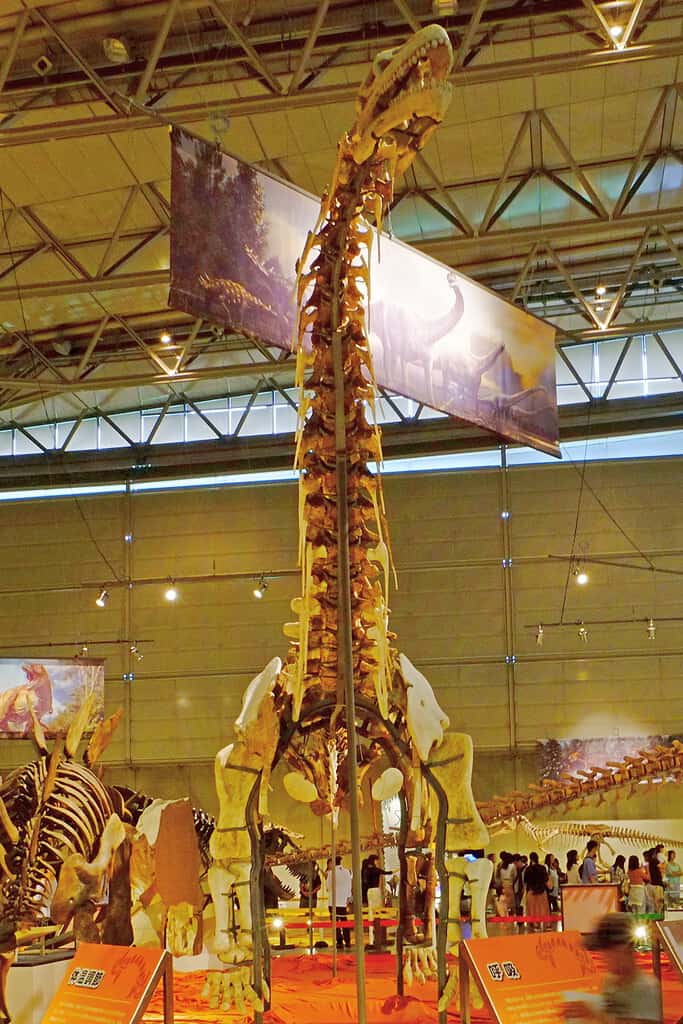
Skeletal reconstruction of
Xianshanosaurus shijiagouensison display.
©★Kumiko★ / CC BY-SA 2.0 – License
Xianshanosaurus is a genus of sauropod dinosaur that lived during the Early Cretaceous period (Aptian-Albian ages). Researchers named the type species Xianshanosaurus shijiagouensis in 2009 from partial remains found in the Mangchuan Formation in Henan Province, China, near Xian Mountain (xiànshān). It has been described as a large herbivore that may have been a titanosaur, but its exact taxonomy remains debated.
5. Xiaosaurus
pronunciation: zhow-sor-us
name means: “dawn lizard”
Xiaosaurus is a genus of ornithischian dinosaur that lived during the Middle Jurassic period. Researchers named the type species Xiaosaurus dashanpensis in 1983 from partial postcranial remains found in the Xiashaximiao Formation in Sichuan Province, China. They described it as a small herbivore measuring about 1 m in length and 7 kg in weight.
6. Xiaotingia
pronunciation: zhow-tin-gee-ah
name means: named after paleontologist Zheng Xiaoting
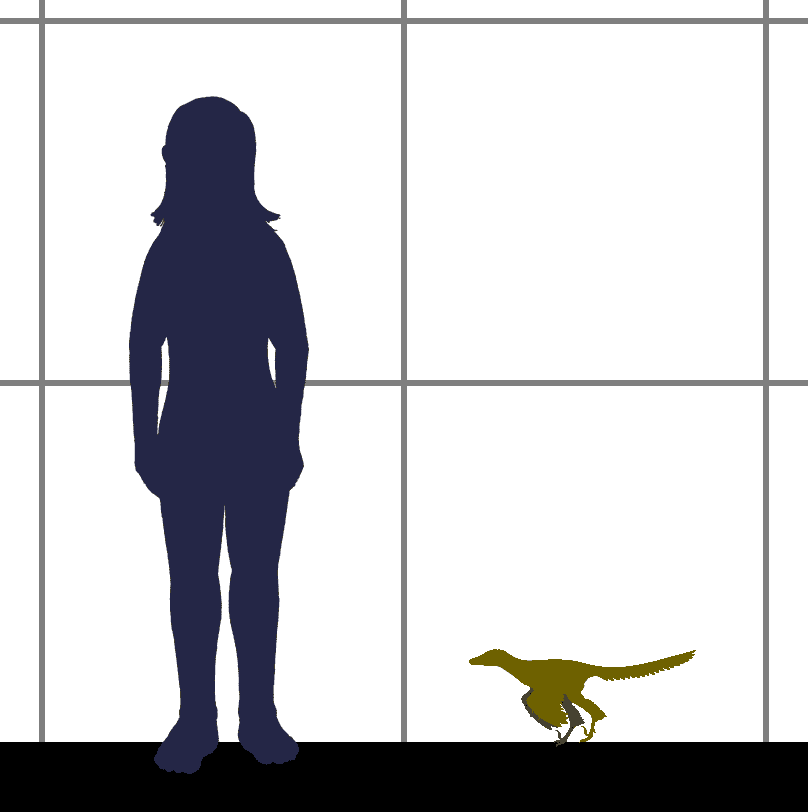
Size comparison between a human and
Xiaotingia zhengi.
©Conty / CC BY 3.0 – License
Xiaotingia is a genus of anchiornithid theropod dinosaur that lived during sometime during the Middle Jurassic or early Late Jurassic periods. Researchers named the type species Xiaotingia zhengi in 2011 from a nearly complete articulated skeleton found in the Tiaojishan Formation in Liaoning Province, China. The binomial name honors paleontologist Zheng Xiaoting. They described it as a small feathered predator about 60 cm long.
7. Xingxiulong
Pronunciation: zing-ze-u-long
Name means: “Xingxiu Bridge dragon”
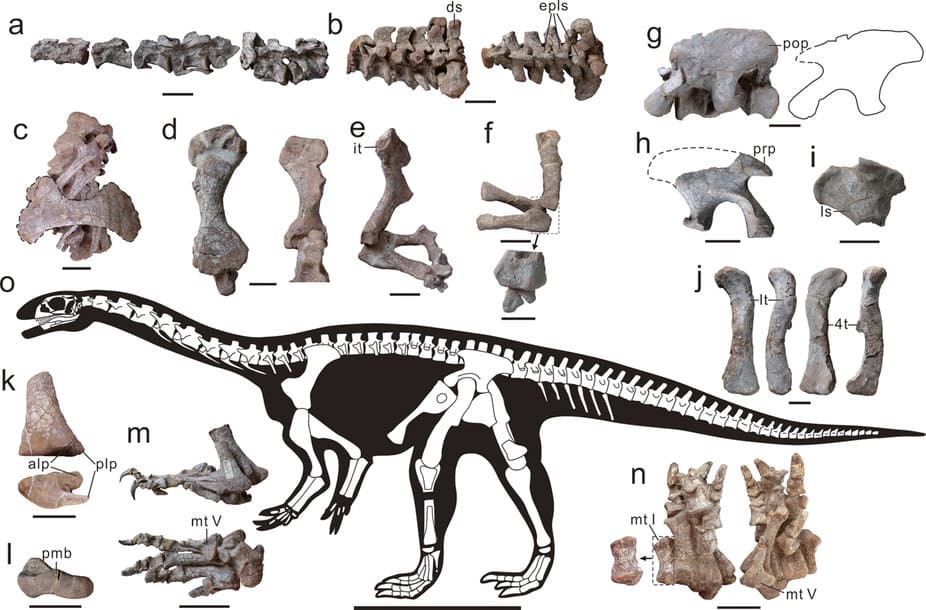
Skeleton holotype of
Xingxiulong chengi.
©Ya-Ming Wang, Hai-Lu You & Tao Wang / CC BY-SA 4.0 – License
Xingxiulong is a genus of sauropodomorph dinosaur that lived during the Early Jurassic period. Researchers named the type species Xingxiulong chengi in 2017 from partial remains of at least two adults and one juvenile found in the Lufeng Formation in Yunnan Province, China. The genus name refers to the Xingxiu Bridge, constructed during the Ming Dynasty, while the species name honors Professor Zheng-Wu Cheng. They described it as a bipedal herbivore about 4-5 m long and 1-1.5 m tall.
8. Xingtianosaurus
Pronunciation: zing-te-an-o-sor-us
Name means: “Xingtian lizard”
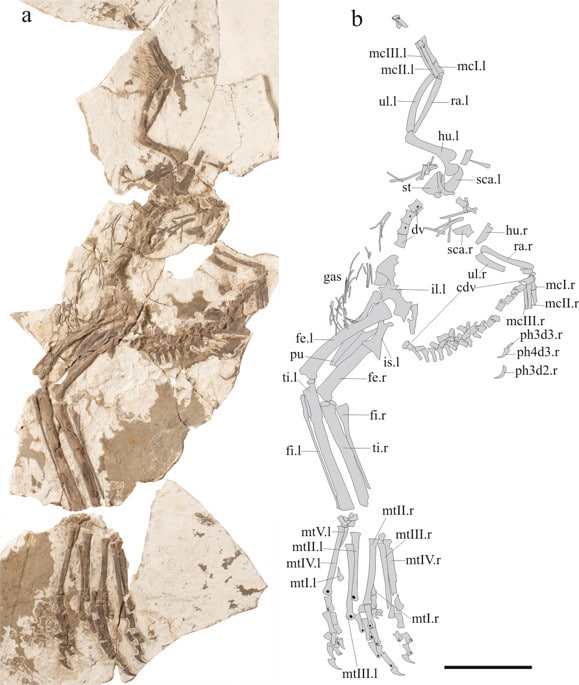
Photograph and diagram of the
Xingtianosaurus ganqiholotype.
©Rui Qiu, Xiaolin Wang, Qiang Wang, Ning Li, Jialiang Zhang & Yiyun Ma / CC BY-SA 4.0 – License
Xingtianosaurus is a genus of caudipterid theropod dinosaur that lived in the Early Cretaceous period. Researchers named the type species Xingtianosaurus ganqi in 2019 from an almost complete postcranial skeleton found in the the Dakangpu Beds of the Yixian Formation in Liaoning Province, China. The genus is named for the Chinese deity Xiangian, who continued to fight even after being decapitated (in reference to the fossil being found without its head); the species name refers to the battle axe he wielded. They described itas a feathered oviraptorsaur.
9. Xinjiangovenator
Pronunciation: zin-je-ang-o-ven-ah-tor
Name means: “Xinjiang hunter”
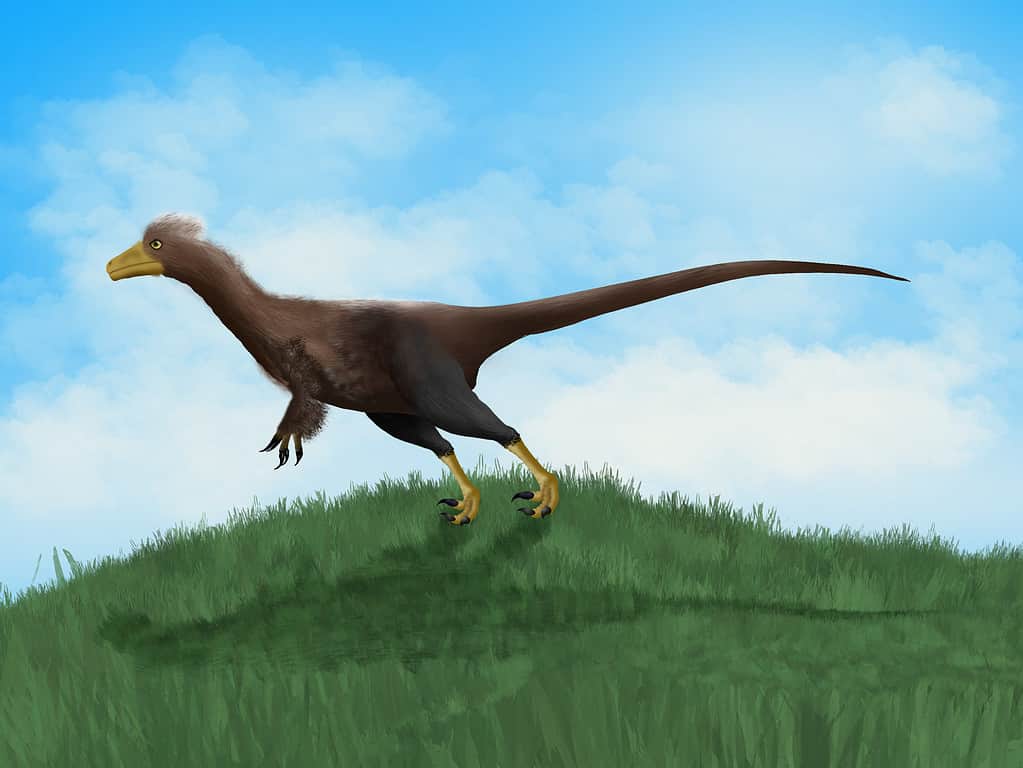
Artist’s reconstruction of
Xinjiangovenator parvus.
©Ruruty25 / CC BY-SA 4.0 – License
Xinjiangovenator is a genus of coelurosaurian dinosaur that lived during the Early Cretaceous period (Valanginian-Albian stages). Researchers named the type species Xinjiangovenator parvus in 2005 from partial postcranial remains found in the Lianmugin Formation of Wuerho, Xinjiang, China. The genus name means “Xinjiang hunter” while the species name is Latin for “small.” They described it as a carnivore that may have measured 3 m in length and 70 kg in weight.
10. Xinjiangtitan
Pronunciation:
Name means: “Xinjiang Titan”
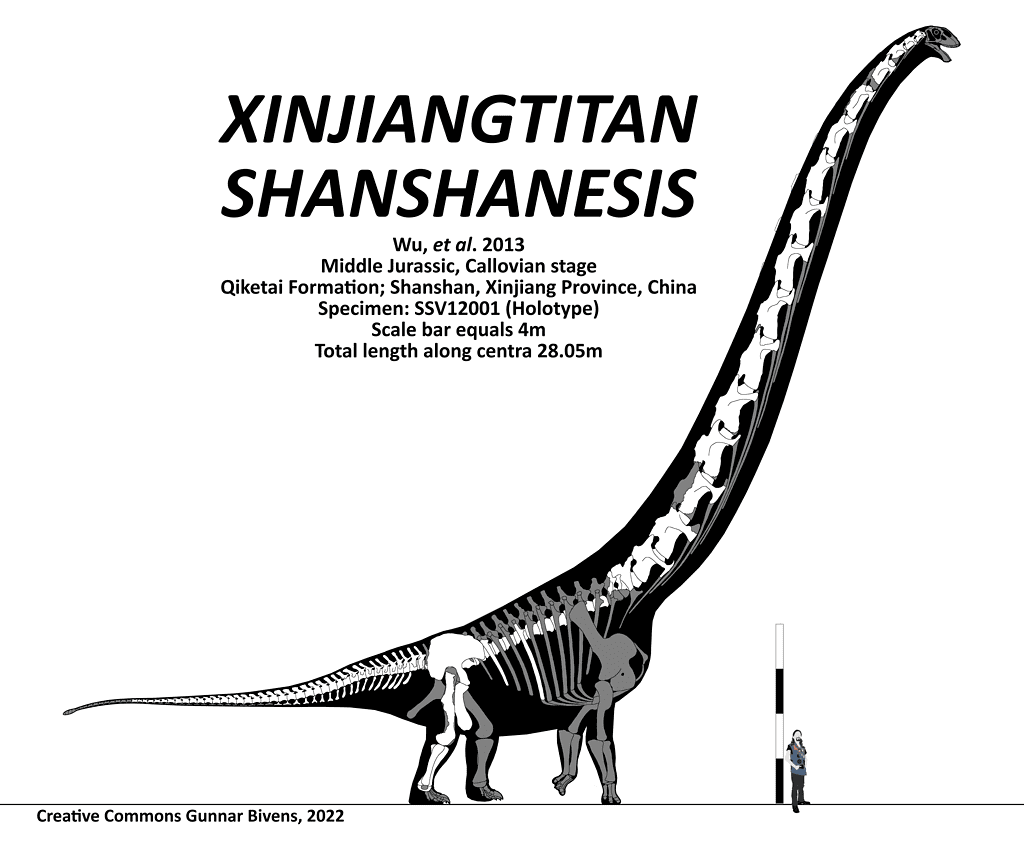
Skeletal reconstruction of
Xinjiangtitan shanshanesiswith size comparison to a human.
©Gunnar Bivens / CC BY-SA 4.0 – License
Xinjiangtitan is an genus of mamenchisaurid sauropod that lived during the Middle Jurassic period. Researchers named the type species Xinjiangtitan shanshanesis in 2013 from a partial skeleton found in the Qiketai Formation in Xinjiang, China. The genus name is a combination of Xingjiang and a reference to the Titans of Greek myhtology, while the species is named for the Shanshan Kingdom. They described it as one of the longest known sauropods, with a total body length of 27-32 m including a neck length of at least 14.9 meters (the longest known for any animal), height of 17 m, and weight of 25-40 mt.
11. Xiongguanlong
Pronunciation: zhong-gwan-long
Name means: “Xiongguan dragon”
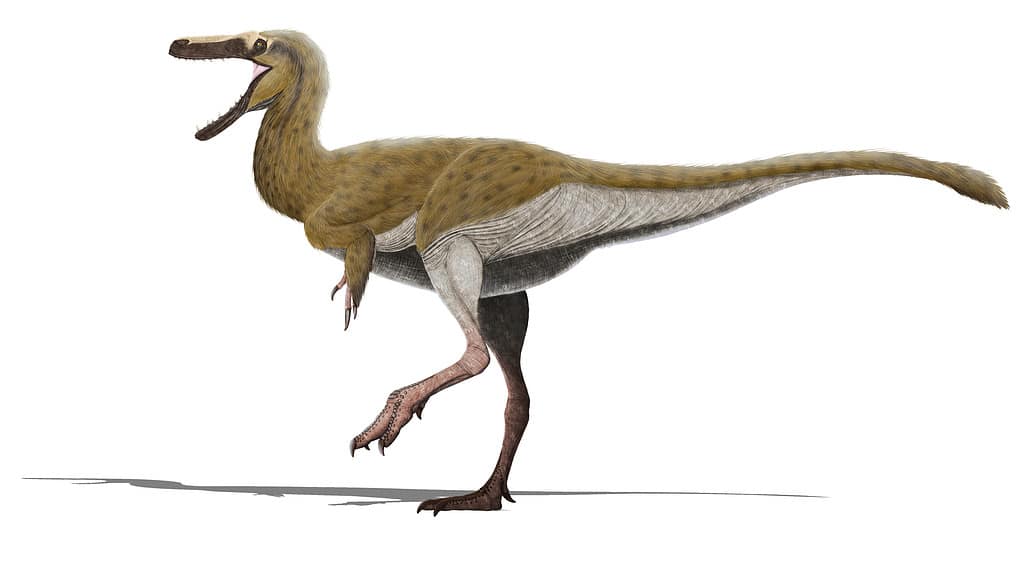
Artist’s reconstruction of
Xiongguanlong baimoensis.
©Cesar Diaz / CC BY-SA 4.0 – License
Xiongguanlong is a genus of tyrannosauroid theropod dinosaur that lived in the Early Cretaceous period (Aptian-Albian periods). Researchers named the type species Xiongguanlong baimoensis in 2009 from a skull and partial postcranial remains found in the Xiagou Formation in Gansu Province, China, in the locality known as “White Ghost Castle.” The genus name refers to the old name for Jiayuguan City (“Xiong Guan“) while the species name is a latinization for the Mandarin word for “white ghost.” They described it as a carnivore about 4-4.5 m long.
12. Xixianykus
Pronunciation: ze-ze-ahn-e-kus
Name means: “Xixia Claw”
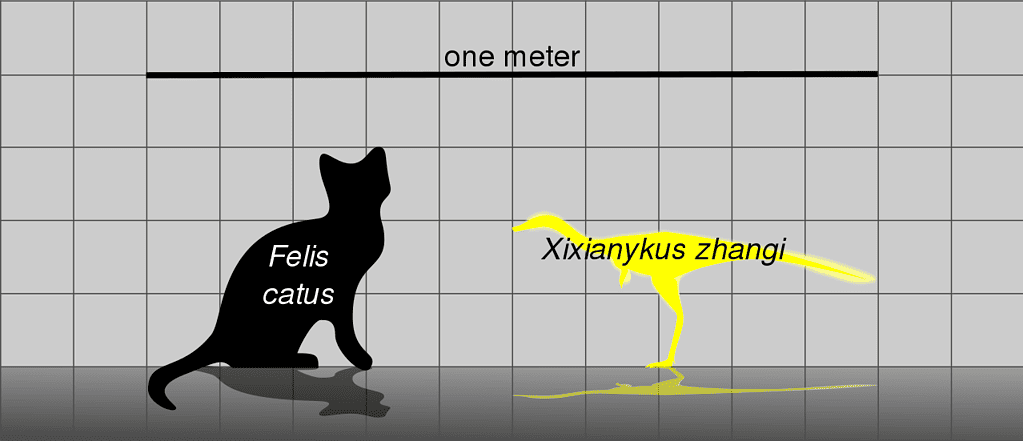
Size comparison of
Xixianykus zhangiand a domestic cat.
©User:Slate Weasel, cat by User:Chris-martin CC0 – License
Xixianykus is a genus of alvarezsaurid theropod dinosaur that lived in the Late Cretaceous period. Researchers named the type species Xixianykus zhangi in 2010 from a partial postcranial skeleton found in the Majiacun Formation in Henan Province, Xixia County, China. They described it as a likely fast-running insectivore that may have been covered in feathers and measured about 50 cm long,
13. Xixiasaurus
Pronunciation: ze-ze-ah-sore-us
Name means: “Xixia Lizard”
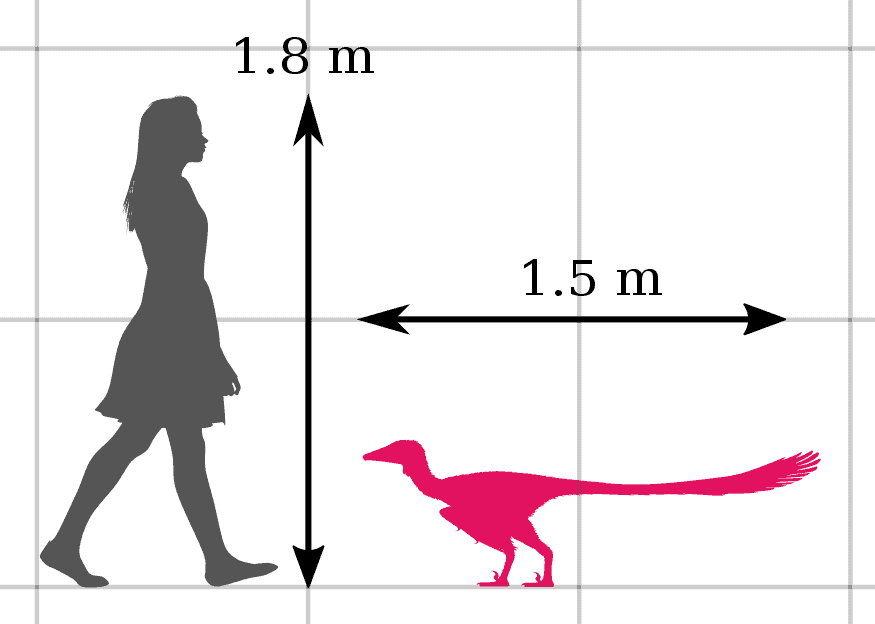
A size comparison between a human and
Xixiasaurus henanensis.
©PaleoGeekSquared / CC BY-SA 4.0 – License
Xixiasaurus is a genus of troodontid dinosaur that lived during the Late Cretaceous period up until the K-T extinction event. Researchers named the type species Xixiasaurus henanensis in 2010 from partial skull and postcranial remains found in the Majiacun Formation in Henan Province, Xixia County, China. They described it as a likely omnivore about 1.5 m in length and 8 kg in weight.
14. Xixiposaurus
Pronunciation: zi-zi-po-sor-us
Name means: “Xixipo Lizard”
Xixiposaurus is a genus of prosauropod dinosaur that lived during the Early Jurassic period. Researchers named the type species Xixiposaurus suni in 2010 from partial remains found in the Lower Lefung Formation in China, near the village of Xixipo. The species name suni honors Professor Sun Ge of Jilin University.
15. Xiyunykus
Pronunciation: zi-yun-e-kus
Name means: “western claw”

Artist’s scaled reconstruction of
Xiyunkus pengicompared in size to a human.
©Tomopteryx / CC BY-SA 4.0 – License
Xiyunykus is a genus of alvarezsaurid dinosaur that lived during the Early Cretaceous period (Barremian-Aptian ages). Researchers named the type species Xiyunkus pengi in 2018 from a partial skeleton found in the Tugulo Group in Western China. They described it as a possible insectivore about 2.3 m long.
16. Xuanhanosaurus
Pronunciation: shwan-han-oh-sore-us
Name means: “Xuanhan lizard”
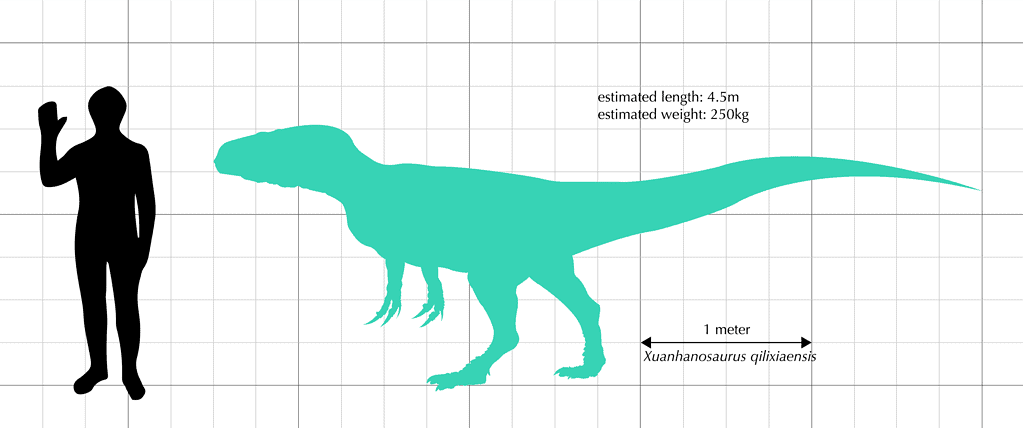
A size comparison between a human and
Xuanhanosaurus qilixiaensis.
©Audrey.m.horn / CC BY-SA 4.0 – License
Xuanhanosaurus is a genus of theropod dinosaur that lived during the Middle Jurassic period (Bathonian age). Researchers named the type species Xuanhanosaurus quilixiaensis in 1984 from a partial skeleton found in the Xiashaximiao Formation Xuanhan County, Sichuan Province, China, near the town of Qilixia. They described it as a carnivore of up to 6 m long.
17. Xuanhuaceratops
Pronunciation: zwan-ha-seh-ra-tops
Name means: “Xuanhua horned face”
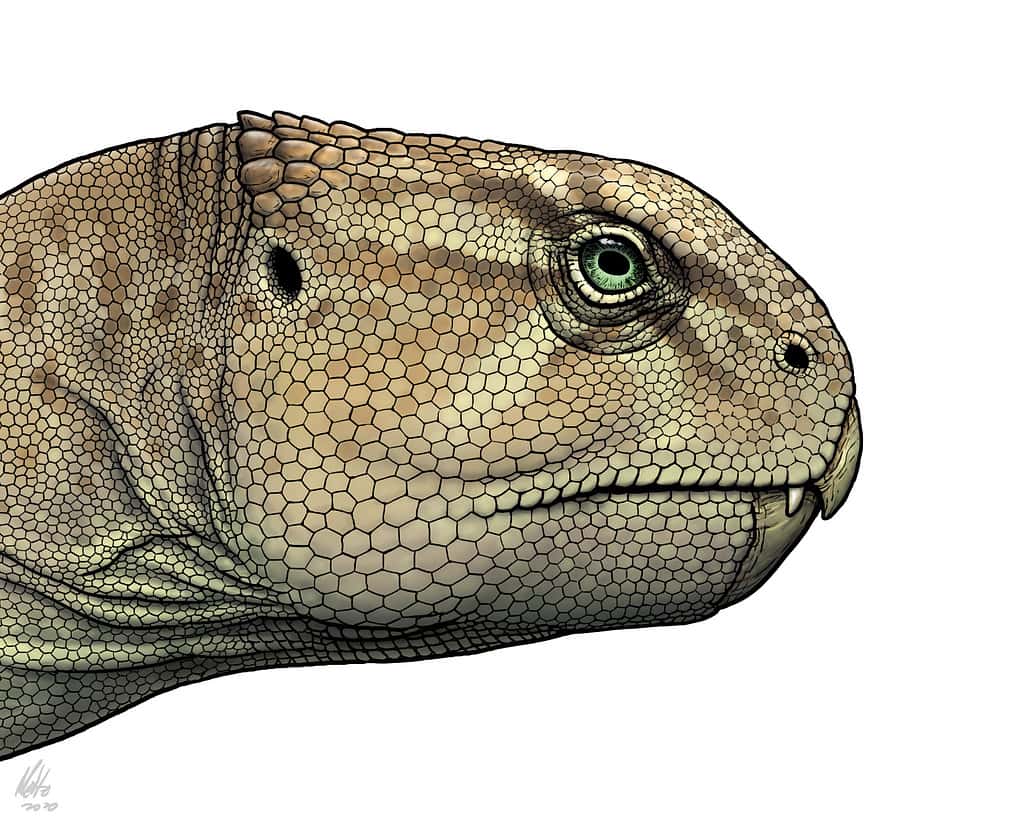
Artist’s reconstruction of the head of
Xuanhuaceratops niei.
©Mette Aumala / CC BY-SA 4.0 – License
Xuanhuaceratops is a genus of chaoyangsaurid cerotopsian dinosaur that lived during the Late Jurassic period (Tithonian stage). Researchers named the type species Xuanhuaceratops niei in 2006 from a partial skull and postcranial remains of four individuals found in the Houcheng Formation in Hebei Province, Xuanhua, China. The species name honours Nie Rongzhen, who found the first fossils back in the 1970s. They described it as a small and swift bipedal herbivore about 90 cm long.
18. Xunmenglong
Pronunciation: zun-meng-long
Name means: “swift dragon”
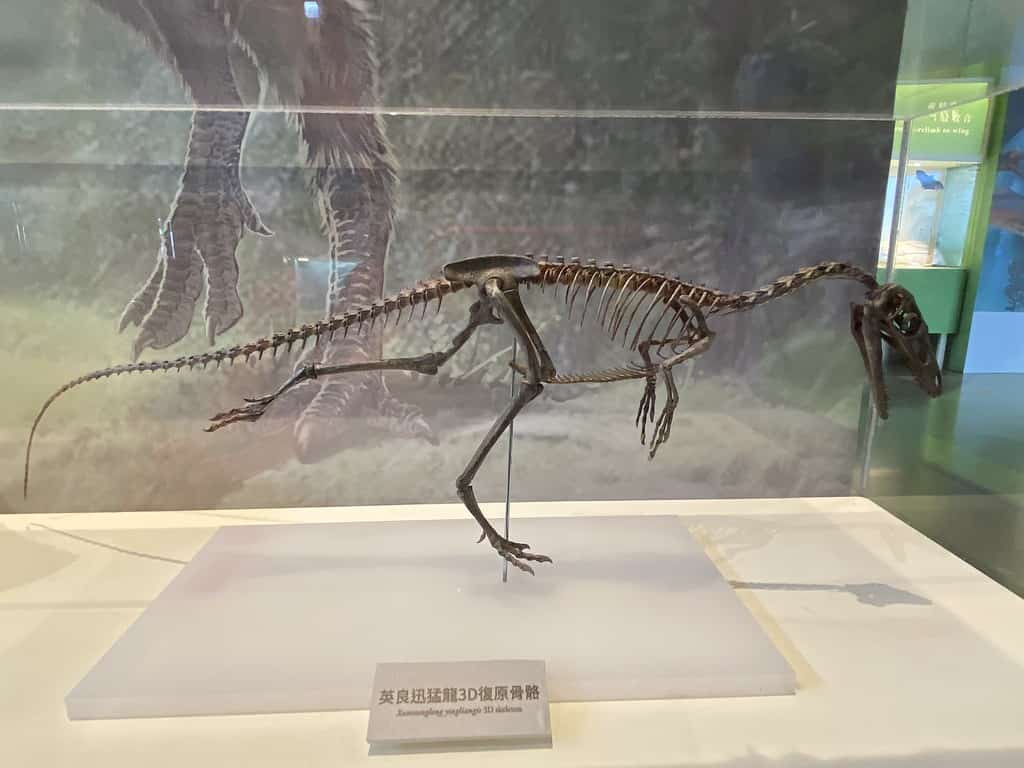
Reconstruction of the
Xunmenglong yinliangisskeleton on display.
©宜蘭第一公民 / CC BY-SA 4.0 – License
Xunmenglong is a genus of compsognathid theropod dinosaur that lived during the Early Cretaceous period. Researchers named the type species Xunmenglong yinliangis in 2019 from partial remains found in the Huajiying Formation in Hebei Province, China. They described it as a small predator approximately 0.5 m long.
19. Xuwulong
Pronunciation: zu-wu-long
Name means: “Xuwu dragon”
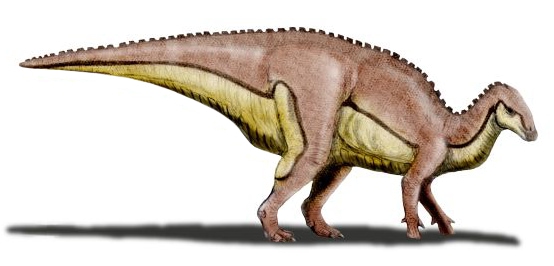
Artist’s reconstruction of
Xuwulong yueluni.
©NobuTamura email:[email protected] palaeocritti / CC BY-SA 3.0
Xuwulong is a genus of hadrosauroid dinosaur that lived during the Early Cretaceous period (Aptian-Albian age). Researchers named the type species Xuwulong yueluni was named in 2011 from a skull and partial skeleton found in the Yujingzi Basin in Gansu Province, China. While the name translates to “Xuwu dragon,” the binomial name is also a reference to Professor Wang Yue-lun (“Xu-wu” is his courtesy name). They described it as an herbivore of unknown size.
Summary of Discover the 19 Dinosaurs That Start With X
| Name | Meaning | Geological Period | Where Found | Year Named |
|---|---|---|---|---|
| Xenoceratops | “alien horned face” | Late Cretaceous | Canada | 2012 |
| Xenoposeidon | “strange Poseidon” | Early Cretaceous | England | 2007 |
| Xenotarsosaurus | “strange tarsus lizard” | Late Cretaceous | Argentina | 1986 |
| Xianshanosaurus | “Xian Mountain lizard” | Early Cretaceous | China | 2009 |
| Xiaosaurus | “dawn lizard” | Middle Jurassic | China | 1983 |
| Xiaotingia | named after paleontologist Zheng Xiaoting | Middle-Late Jurassic | China | 2011 |
| Xingxiulong | “Xingxiu Bridge dragon” | Early Jurassic | China | 2017 |
| Xingtianosaurus | “Xingtian lizard” | Early Cretaceous | China | 2019 |
| Xinjiangovenator | “Xinjiang hunter” | Early Cretaceous | China | 2005 |
| Xinjiangtitan | “Xinjiang Titan” | Middle Jurassic | China | 2013 |
| Xiongguanlong | “Xiongguan dragon” | Early Cretaceous | China | 2009 |
| Xixianykus | “Xixia claw” | Late Cretaceous | China | 2010 |
| Xixiasaurus | “Xixia lizard” | Late Cretaceous | China | 2010 |
| Xixiposaurus | “Xixipo lizard” | Early Jurassic | China | 2010 |
| Xiyunykus | “western claw” | Early Cretaceous | China | 2018 |
| Xuanhanosaurus | “Xuanhan lizard” | Middle Jurassic | China | 1984 |
| Xuanhuaceratops | “Xuanhua horned face” | Late Jurassic | China | 2006 |
| Xunmenglong | “swift dragon” | Early Cretaceous | China | 2019 |
| Xuwulong | “Xuwu dragon” | Early Cretaceous | China | 2011 |
The photo featured at the top of this post is © goir/iStock via Getty Images
Thank you for reading! Have some feedback for us? Contact the AZ Animals editorial team.






